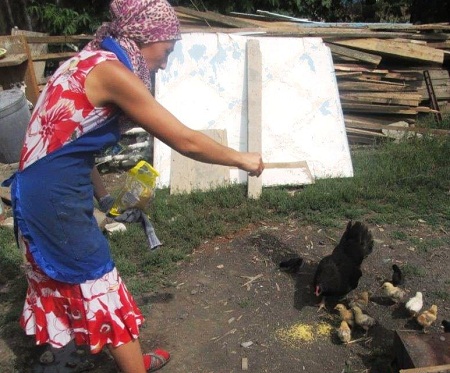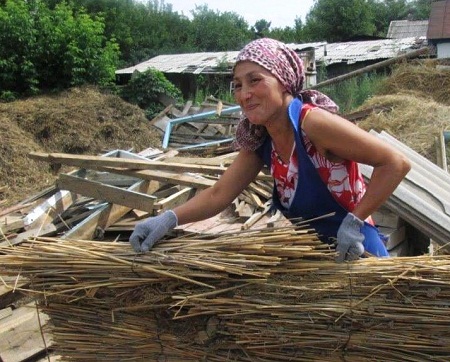Smart Loan Products, Smarter Lending Approach: Kazakhstan’s Asian Credit Fund serves the country’s financially underserved, rural poor
The Central Asian nation of Kazakhstan, one of the first former Soviet Republics to repay all of its debt to the International Monetary Fund, and with a GDP per capita ranking of 57 of 184 countries, doesn’t immediately conjure up images of poverty. But look beyond the major urban centers of Almaty and Astana in this oil-rich country and you’ll see a definite disparity between rich and poor that frames the financial realities throughout the country.
In other words, on paper, Central Asia’s richest nation looks great. However, dig a little deeper and you will see microfinance institutions like Asian Credit Fund (ACF), founded in 1997 by international relief and development organization Mercy Corps, working hard to lift rural households out of entrenched poverty. Following the collapse of the Soviet Union, Mercy Corps established microfinance institutions throughout the former Soviet Central Asia, like ACF’s sister organization, Kompanion Financial Group in Kyrgyzstan, to boost community economies.
The most prosperous of the post-Soviet republics due to its vast natural resources, Kazakhstan is an upper-middle-income country which reported a per capita GDP of nearly $13,000 in 2013. Increasing domestic demand from a growing middle class, coupled with increased oil and gas production and steadily rising crop yields generating agricultural exports, boosted GDP growth from 5 percent in 2012 to 6 percent in 2013. Recently, the government began cooperating with microfinance institutions to address systemic poverty in rural regions through programs that have helped decrease national poverty levels from 5.5 percent in 2011 to 3.8 percent in 2012. ACF is one of these MFIs that has been working with one of the country’s most neglected populations – remote, rural households living in poverty.
Since its founding in 1997, ACF has become known for its increasingly robust product development approach customized to address the unique Kazakh context. And since 2009, when ACF began to target the country’s most remote rural areas, the company has spearheaded efforts to innovate the fight against poverty by adapting its products to the rural context, with a sustainable twist.
Mercy Corps interviewed Zhanna Zhakupova, executive director of ACF, for a glimpse into how the company’s innovative loan products and lending approaches are serving the country’s rural poor.
Mercy Corps: Could you provide some context for ACF’s work in Kazakhstan’s financial sector?
Zhanna Zhakupova: After the fall of the Soviet Union in 1991, Kazakhstan tried to establish itself as an independent state. Numerous reforms to liberalize prices and reduce trade distortions were implemented to strengthen the economy. Most of these reforms were meant to benefit the country’s burgeoning small and medium enterprises.
Following its founding in 1997, during a period of nationalized efforts to boost the country’s economy, ACF focused solely on small business development. In 2006, MFIs began to gain traction in Kazakhstan’s financial sector. They were allowed to register as micro-lending organizations and were recognized as financial institutions by the country’s National Bank. Five years after the national deregulation of MFIs, which occurred in 2006, their numbers had increased by 400 percent (from 356 in 2006 to 1,780 in 2011), but most of them continued to serve only small and medium enterprises, with hardly any focus on individual entrepreneurs and especially rural households.

In 2008, the global financial crisis destabilized the macroeconomic climate in Kazakhstan, from which it is still recovering. Recognizing an opportunity, ACF refocused its financial product line to include group lending for rural households. This also helped ACF brave the torrential financial storm of 2008-09 which also severely impacted the indigenous banks in Kazakhstan. As a result of this shift in focus, ACF became one of the few sustainable MFIs in the country.
MC: What is it that makes ACF stand out among the country’s hundreds of financial institutions?
ZZ: In a country with so many financial institutions, it might be surprising to learn that ACF is one of the few that targets the poorest households in Kazakhstan’s rural regions. For example, ACF’s average disbursed loan size, $680, or 5.6 percent of per capita GNI (2012), compares extremely favorably with the average loan size of ACF’s rural MFI competitors in Kazakhstan ($1,600). In the country’s urban centers, MFIs regularly disburse “microloans” of up to $50,000.
Furthermore, ACF supports the country’s most vulnerable population – rural women, who comprise 99 percent of the company’s client base. When ACF first started disbursing group loans in 1997, men and women were equally targeted as potential clients, but over time ACF noticed that women exhibited more responsible borrowing characteristics, despite the fact that men tended to dominate mixed loan groups. ACF noticed that women typically spent money for the benefit of their families, whereas their male counterparts exhibited more selfish spending behavior. This realization led ACF to target women, a change that was instrumental in the fight against poverty at the household level.
ACF’s loan products also feature technical assistance, like financial literacy and technical training, that has helped households build sustainable livelihoods. A testimony to ACF’s compliance and endorsement of international standards, like the SMART Campaign, is its mission to serve clients and improve quality of life.
Within a local context, however, ACF faces daily challenges in serving its clients sustainably. Kazakhstan is a country with one of the lowest population densities in the world – approximately 5.5 people per square kilometer. Most of the country’s poor are situated within these extremely sparsely populated areas, with the country’s rich inhabiting large cities like Almaty and Astana. Providing loans in these areas is expensive due to a lack of large concentrations of people, resulting in large amounts of time spent to serve a relatively small number of clients. For most clients, reaching a local ACF branch is equally as time consuming with a high opportunity cost.
But we understand that for most clients living in Kazakhstan’s rural areas, ACF is a financial partner dedicated to serving poor households, and one that is able to manage the high costs associated with serving these low-density areas.

MC: What are ACF’s plans for the future?
ZZ: We plan to at least double our client base over the coming years. We also have plans to pilot and scale up new agricultural loan products, including loans for small greenhouses, which will support local vegetable production year round and replace expensive imports. We are also planning to target smallholder farmers, currently neglected by financial programs offered by the Kazakh government, whose policies usually focus more on large farms and industrial agriculture production. We will also focus on green lending practices to encourage environmentally friendly investments as well as educational loans to serve a variety of needs in Kazakhstan’s remote regions.
These new loan products will also feature ACF’s trademark technical assistance components, including financial literacy training, to ensure that clients develop basic financial skills and avoid making financial mistakes that can impact a household, and also to help our clients increase returns on their investments and comfortably repay their loans.
Currently, smallholder farmers do not practice any kind of agro-analysis when they consider taking a loan for their business. To address this, ACF plans to partner with modern agricultural laboratories to carry out scientific analyses and to provide technical recommendations on crop suitability, fertilizer usage and sustainable farming practices. ACF also plans to intensify its plans to improve the energy efficiency of rural households to decrease dependency on fossil fuels, which are expensive and sometimes scarce for rural populations.
MC: What has ACF done already along these lines?
ZZ: Since 2012 ACF has disbursed approximately $700,000 to 249 rural households to increase energy efficiency measures such as home insulation and heating system upgrades. The loans, disbursed under ACF’s Residential Energy Efficient Lending Program with financial and technical support from USAID, averaged $3,200 per household. Each loan was accompanied by services that emphasized the creation of detailed construction budgets and that trained clients on the importance of modern heating systems and construction materials. Analysis showed that the energy savings associated with these loans was a decrease of carbon emissions totaling 471 tons.
The next step in ACF’s mission to promote sustainability and efficiency in rural Kazakh villages is to send four ACF employees to the United States in 2014 for training on energy savings and sustainability through the USAID Community Links Program. We hope that our next step after this endeavor will be the promotion of renewable energy in Kazakhstan.
In order to further improve our service to our clients and to grow our business, ACF is actively working to attract investments to expand our ability to reach rural Kazakh households and to promote financial inclusion. ACF recently secured an equity investment of $500,000 from BOPA (Base of the Pyramid Asia), which will increase our pool of capital for lending by $3 million this year. The hope is to continue this trend so that ACF can expand its services to more of Kazakhstan’s rural regions and bring more people out of poverty.
Over the next decade, ACF plans to become a leader in development microfinance in and throughout Central Asia – with potential in other rural areas of Kazakhstan and parts of Uzbekistan. If ACF’s lending model continues to demonstrate success among extremely remote, poor households it could have the potential to boost innovative financial inclusion in Central Asia’s poorest regions.
Emily Youatt is Kompanion Financial Group’s marketing and development specialist, based out of Bishkek, Kyrgyzstan.
Rinchin Gaekwad was Mercy Corps Kyrgyzstan’s 2014 field intern. She is currently studying for a master’s degree in Paris, France.
- Categories
- Uncategorized
